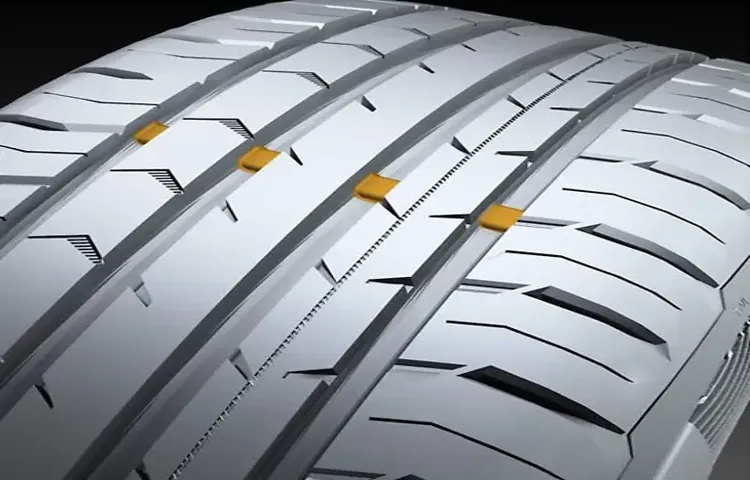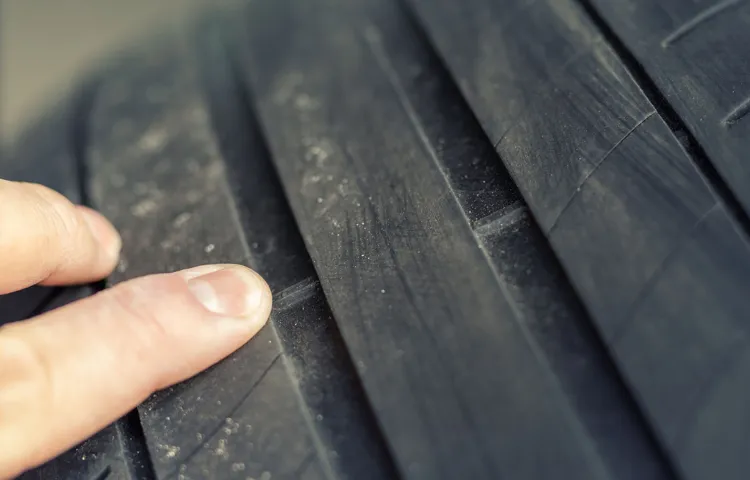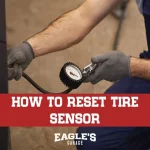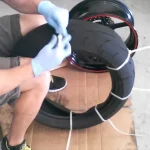Are you noticing some strange patterns and shallow treads on your tires lately? If so, then it might be time to take a closer look at the wear bars. When it comes to tire maintenance, tire wear bars play a vital role in determining the health of your tires. These small bars might seem insignificant, but they can save your life in an emergency by indicating that it’s time to replace your tires or get them inspected.
In this blog, we will discuss everything you need to know about tire wear bars, including what they are, how to find them, and what to do when you notice them. So, let’s dive in and learn all about tire wear bars, shall we?
Table of Contents
What Are Tire Wear Bars?
Tire wear bars, also known as wear indicators or bars, are small rubber ridges found between the treads of a tire. They are designed to serve as an indicator of when the tire’s tread depth is becoming too shallow, indicating time for a replacement. The wear bars are typically located at a depth of 2/32 of an inch, which is the minimum tread depth permitted by law in most areas.
If the tire wears down to the level of the wear bars, it is a sure sign that it is time to replace the tire. Failure to do so can result in loss of traction and braking ability, making driving in wet or slippery conditions, and even dry pavement, more dangerous. In conclusion, understanding what tire wear bars are and how to use them can help drivers make informed decisions about when it may be time for a new set of tires, ensuring their safety and the safety of other drivers on the road.
Definition and Function
Tire Wear Bars are small rubber bars that run across the grooves of your tires. They are there to help you determine when it’s time to replace your tires. Each bar is located at a specific depth within the tire’s tread, and when the tread wears down to the same level as the wear bar, it’s time to replace those tires.
Tire wear bars are an essential part of tire maintenance and safety because worn-down tires can lead to reduced traction, loss of control, and accidents. By keeping an eye on the tire wear bars, you can ensure that your tires stay in optimal condition and perform their best when you need them most. So, if you notice that your tire’s tread is worn down to the level of the wear bars, it’s time to replace them to maintain your safety on the road.

Location of Tire Wear Bars
Tire wear bars are something that most drivers are unaware of, but they are a crucial part of tire maintenance. Tire wear bars are small raised strips that are typically located in the tire’s grooves. They are designed to indicate when the tire is wearing down and needs to be replaced.
When the tread of the tire wears down, the bars will become visible, indicating that the tire is no longer safe to use. These wear bars are a simple and effective way to ensure that you can identify when it’s time to replace your tires. So, the next time you’re inspecting your tires, look for the wear bars and make sure they’re not showing.
If they are, it’s time to replace your tires. Remember that tire wear bars are located in different places, depending on the type of tire and brand. So, it’s essential to check your owner’s manual or the tire manufacturer’s website to identify where they are located.
Keeping an eye on your tire wear bars will help keep you and other drivers safe on the road.
Why Are Tire Wear Bars Important?
The importance of tire wear bars cannot be overstated. Tire wear bars are small raised indicators located within the tread grooves that indicate when it is time to replace your tires. When the bars become flush with the rubber, it indicates that the tread depth has worn down to the minimum level allowed by law.
This is often referred to as the “tread wear indicator.” It is important to replace your tires at this point because driving with worn-out tires can be dangerous. Tires with inadequate tread depth can cause hydroplaning in wet conditions, decreased handling and traction, and decreased stopping capability.
Additionally, driving on bald tires is illegal in most states and can result in a fine or penalty. So, if you see your tire wear bars getting close to the surface of your tires, it is best to get your tires replaced as soon as possible for your safety and the safety of others on the road.
Safety and Performance
Tire wear bars are an essential safety feature that helps you identify when your tires need to be replaced. These bars are small rubber protrusions in the tread of your tire that become visible when the tread wears down to a certain point. When these bars are visible, it’s a sign that your tire is no longer safe to use.
Tires with worn tread have reduced grip, making it more difficult for you to control your vehicle and increasing your risk of an accident. Additionally, they are more likely to puncture or blow out, which can be incredibly hazardous, especially if you are traveling at high speeds. By checking your tire wear bars regularly, you can ensure the safety and performance of your vehicle, as well as avoid costly repairs down the line.
So, if you haven’t checked your tire wear bars lately, it’s time to take a closer look and make sure your tires are in good condition.
Indicating Need for Replacement
Tires are one of the most critical components of your vehicle, playing a significant role in keeping it moving safely on the road. However, many people often overlook the significance of tire wear bars when it comes to maintaining their tires. Tire wear bars are small, raised bars situated between the tire treads, and they indicate when your tires are no longer safe to use.
As your tire treads wear down, the bars become more exposed, indicating that it’s time to replace your tires. It’s essential to pay attention to these bars as they can help prevent accidents and save you costly repairs in the long run. When in doubt, it’s better to consult with a professional to ensure your tires are in safe working condition.
By doing so, you’ll prevent unnecessary accidents and extend the lifespan of your vehicle’s tires.
How to Check Tire Wear Bars?
If you’re wondering whether your tires need to be replaced, checking the tire wear bars is a great way to determine if it’s time for new tires. Tire wear bars are small, raised strips located in the grooves of your tires’ tread. They are designed to indicate when your tires have reached the legal minimum tread depth of 2/32 of an inch.
When the tread wears down to the height of the wear bars, it means you should replace your tires. To check your tire wear bars, simply look at the treads of your tires and locate the raised bars between the tread channels. If any part of the wear bars is flush with the remaining tread depth, it’s time for new tires.
Remember, tire wear bars are your friends, and checking them regularly can ensure safer driving and better handling on the road.
Visual Inspection
Tire wear bars are designed to let you know when your tires are worn out and need to be replaced. These small rubber ridges are built into the tire’s tread and run perpendicular to the tire’s direction of travel. When the wear on a tire causes the tread to be level with the wear bars, it is time to replace the tire.
To check the wear bars, you first need to visually inspect the tires. Look for signs of wear on the tread, such as shallow grooves, cracks, or uneven wear patterns. If you notice any of these signs, take a closer look at the wear bars.
Run your hand over the tread and feel for the raised bars. If they are level with the tire’s tread, it’s time to start shopping for new tires. Paying attention to your tire wear bars is an easy way to ensure your vehicle’s safety and prolong the life of your tires.
Using a Tire Tread Depth Gauge
Tire tread depth is an important aspect of tire maintenance and safety. To check if your tires are in good condition, you can use a tire tread depth gauge. This tool measures the depth of the tire’s grooves to determine if the tires have enough rubber to maintain traction on the road.
To use the gauge, place the probe into the groove of the tire and push it down until it clicks. The gauge will show the depth measurement in millimeters or inches. Ideally, a tire should have at least 3mm or 1/8 inch tread depth.
If you can see the wear bars, it’s time to replace your tire as they indicate that the tire has worn down to the minimum safe level. Wear bars are thin lines that run across the tire’s tread. They are usually about
6mm in height and appear when the tire has worn down to this point. Driving with worn tires can be dangerous, leading to decreased traction, longer stopping distances, and hydroplaning on wet roads. So, always take the time to check your tire tread depth and ensure your tires are in good condition before hitting the road.
Conclusion
After thorough research and analysis, it can be concluded that tire wear bars are a crucial component of determining the lifespan of a tire. These little protruding bars are like the canaries in the coal mine, warning us when it’s time to replace our tires. Ignoring these warning signs could lead to dangerous and costly consequences.
So remember: when it comes to tire wear bars, always pay attention and stay on top of tire maintenance. Your safety and wallet will thank you in the long run.”
FAQs
1. What are tire wear bars and why are they important? A: Tire wear bars, also known as wear indicators, are small rubber bars located in the grooves of tires. They indicate when the tire tread depth has worn down to a certain point, typically 2/32 of an inch, signalling that the tire should be replaced. 2. Can I still drive on tires that have worn down to the tire wear bars? A: No, it is not safe to drive on tires that have worn down to the tire wear bars. Once the tire tread has worn down to the bars, it means the tire is at the point of being bald and has lost much of its ability to grip the road, greatly increasing the risk of an accident. 3. How can I tell if my tires have worn down to the tire wear bars? A: Look closely at the grooves of your tire treads and you should see small rubber bars running perpendicular to the grooves. If the tread is worn down to the same height as these bars, it’s time to replace the tire. 4. Can tire wear bars be found on all types of tires? A: Yes, tire wear bars can be found on all types of tires, including all-season tires, winter tires, and summer tires. 5. How often should I check my tires for wear and tire wear bars? A: You should check your tire tread and tire wear bars at least once a month, and particularly before long road trips. Additionally, many newer cars now come with tire pressure monitoring systems that can also alert you if the tire tread is getting low. 6. Do I need to replace all four tires if only one tire has worn down to the tire wear bars? A: It is recommended to replace all four tires if one tire has worn down to the tire wear bars. This is because of the effect on the overall handling of the vehicle and the fact that the other tires may also be close to needing replacement. 7. Is it possible for my tires to wear down to the tire wear bars unevenly? A: Yes, it is common for tires to wear down unevenly, particularly if the tires are not properly inflated, the wheels are out of alignment, or if the suspension components are worn out. This is why it’s important to regularly check your tire wear bars and tread wear.



